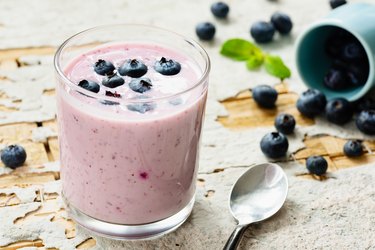
If you need a quick boost of energy before a workout or a refreshing recovery drink after you exercise, drinking a whey protein shake is a great option. Blend in some fresh fruit, and you'll have a grab-and-go meal that not only satisfies hunger but also helps you met your daily protein needs.
Tip
You can use fresh or frozen fruit when making a whey protein shake. For the best results, use a blender.
Video of the Day
Whey Protein Shake
Whey protein is a by-product of the cheese-making process, according to the Mayo Clinic. Along with casein protein, whey is one of the two main proteins in milk, which is important to note for people with a dairy allergy or lactose intolerance.
Video of the Day
Since whey protein powder contains all of the amino acids your body needs, it's considered a complete protein, which makes it a good choice for building muscle, according to the Cleveland Clinic. For muscle growth, they say whey protein and whey isolates are your best options since they have a high biological value. In other words, your body can easily absorb and use whey protein.
A January 2016 meta-analysis published in the journal Sports Medicine found that whey protein supplementation, administered alone or as part of a multi-ingredient, in combination with resistance training, was associated with small extra gains in fat-free mass or lean body mass.
According to the USDA, one scoop of whey protein powder isolate has 103 calories, 0 grams of fat, 8 grams of carbohydrates, and approximately 18 grams of protein. It's important to note that these figures are based on a generic protein powder. For exact nutrition information, refer to the product label on the protein powder you're using.
Read more: Is Whey Protein Good or Bad?
Tips for Making Fruity Shakes
Once you've settled on a protein powder, it's time to experiment with some different recipes. To make your whey protein shake easy to consume, you need to add a liquid such as water, milk, almond milk or juice. For a low sugar shake, stick to water or unsweetened almond milk.
Some people like to use a fruity protein powder flavored with their favorite berry, but you can also buy plain or vanilla powder and add fresh or frozen fruit. When it comes to fresh or frozen the Academy of Nutrition and Dietetics says all fruits, whether fresh, frozen, canned or dried are good for you.
However, if you buy frozen fruit, make sure it is only the fruit and does not contain any added syrups. And avoid using canned or dried fruit. They don't mix well in a whey protein shake. A simple fruit protein shake could include the following ingredients:
- 1 scoop of protein powder
- 1 cup of liquid such as water, milk, almond milk
- 1/2 cup of ice (if you are using fresh fruit)
- 1/2 cup of berries like strawberries, raspberries, blueberries, blackberries,
- 1/2 banana
- 1/2 cup of pineapple or mango
- Add all of the ingredients to a blender and blend on medium for 60 seconds or until you reach the desired consistency.
Note: If you are using frozen fruit, you can skip the ice. To make fruit protein shakes that are thick, add less liquid. If you like your whey protein shake thin and easy to drink, stick with the recommended amount of liquid or add more.
When using a blender, you can always add as you go. If fruit protein shakes are part of your regular diet, consider swapping out the ingredients a few times a week. Papaya, peaches, grapes (frozen works the best), coconut and kiwi are all excellent additions, and when combined, make the best breakfast protein shake.
Whey Protein Dangers
In general, whey protein powder is safe for consumption. That said, there are some things to consider before you add this supplement to your diet. The U.S. Food and Drug Administration does not review dietary supplements for safety and effectiveness before they're marketed; that's left up to the manufacturer. Which means you need to do your research before buying protein powder and pay attention to any adverse side effects.
According to the Mayo Clinic, certain medications and whey protein may not be a good fit. Albendazole, which is a parasite-killing drug, may not work as well if you're also using whey protein. Alendronate, which treats osteoporosis, might not be absorbed as well, and whey protein powder may also limit the absorption of certain antibiotics such as quinolone or tetracycline.
Additionally, Harvard Health reports that a nonprofit group called the Clean Label Project screened 134 products for 130 types of toxins and found that many protein powders contained heavy metals, pesticides or other contaminants. The problem, they say, lies in the manufacturing process or the existence of toxins in the soil.
It's always a good idea to talk with your doctor if you have any questions or concerns about adding a supplement to your diet.
- Cleveland Clinic: "7 Tips for Choosing the Best Protein Powder for You"
- U.S. Department of Agriculture, MyFoodData: "Nutrition Facts for Whey Protein Powder Isolate"
- Sports Medicine: "Effects of Whey Protein Alone or as Part of a Multi-Ingredient Formulation on Strength, Fat-Free Mass, or Lean Body Mass in Resistance-Trained Individuals: A Meta-Analysis"
- Mayo Clinic: "Whey Protein"
- Harvard Health: "The Hidden Dangers of Protein Powders"
- U.S. Food and Drug Administration: "What You Need to Know About Dietary Supplements"
- Academy of Nutrition and Dietetics: "Fresh, Canned or Frozen: Get the Most From Your Fruits and Vegetables"